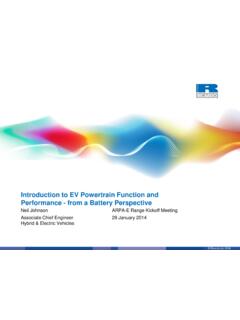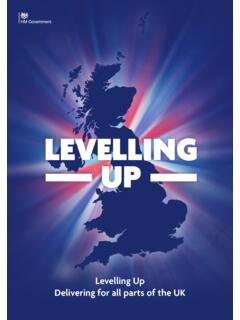Transcription of Integrated Rail Plan for the North and the Midlands ...
1 Integrated Rail Plan for the North and Midlands Technical Annex The analysis presented in this technical annex provides supporting evidence for the decisions made in the Integrated Rail Plan based on work undertaken in 2020 and 2021. The latest economic analysis for High Speed Rail (Crewe-Manchester) Bill is published in the update on the Strategic Outline Business Case accompanying the deposit of the Bill. January 2022 Department for Transport Great Minster House 33 Horseferry Road London SW1P 4DR This publication is licensed under the terms of the Open Government Licence except where otherwise stated. To view this licence, visit or contact, The National Archives at Where we have identified any third-party copyright information you will need to obtain permission from the copyright holders concerned. This publication is also available on our website at Any enquiries regarding this publication should be sent to us at Table of Contents Executive summary 4 2 Overview of Analytical Approach 7 Value for Money assessment 8 Assessment against strategic objectives 9 3 Summary of IRP options analysed 12 HS2 Phase 2b Eastern Leg 13 Northern Powerhouse Rail 15 Total IRP Package 17 4 Value for Money 18 Detailed assumptions 18 Benefits 19 Costs 20 Uncertainty 22 Presentation of VfM categories 22 5 Strategic assessment of options 25 Summary of outputs 25 Outputs (including Value for Money) 25 Integrated Rail Plan for the North and Midlands Technical Annex 4 Executive summary This technical annex sets out the analysis and evidence developed by the Department for Transport which has supported the development of the Integrated Rail Plan (IRP) and the options for the schemes it covers.
2 The IRP seeks to address major capacity, frequency, reliability, and speed shortfalls on the existing network; maximise integration with existing local transport networks; serve destinations people want to reach; deliver carbon savings; avoid disadvantaging existing passengers and users; and minimise the impact on communities, especially those which don t benefit directly. It sits at the heart of the Government s plans to level up the whole country, build back better, and move to net zero greenhouse gas emissions. It seeks to deliver the frequent and reliable services that millions of rail users in the North and Midlands deserve. We intend to take an adaptive approach to investment, allowing the programmes set out in this Plan to evolve in the light of future demand and cost information. That means we are as the National Infrastructure Commission (NIC) recommended setting out a core pipeline of commitments now, recognising that other potential future schemes could be added, if these projects are delivered on time, to budget, and depending on how demand and economic growth recover.
3 In developing the evidence base to support decisions on the IRP the aim has been to assess the different options for the schemes within the plan against its strategic objectives, including an early assessment of value for money (VfM). This is a proportionate approach to the assessment of the various schemes at this early stage in their development to support decisions around preferred options for the IRP. More detailed analysis will be completed as individual schemes are taken forward and business cases developed in line with HMT Green Book and Transport Analysis Guidance (TAG). The IRP is being published against a background of increased uncertainty about the future of demand for rail travel as the country recovers from the COVID-19 pandemic. Options appraisal requires us to forecast demand over the long-term over which uncertainty is likely to increase. The analysis has taken post-COVID economic and population forecasts from the Office of Budget Responsibility (OBR) and Office of National Statistics (ONS) and has accounted for wider uncertainty by following the principles set out in the TAG uncertainty toolkit, testing scenarios around future travel demand to understand how options perform under different scenarios.
4 Integrated Rail Plan for the North and Midlands Technical Annex 5 The schemes set out in the IRP will have long-term impacts. The economic lifetime of these assets is very likely to extend beyond the standard appraisal period of 60 years, particularly where new lines are being proposed. Recent updates to TAG allow the use of a longer appraisal period where it can be demonstrated that the proposed scheme will have impacts over that period. The Value for Money assessment presented here reflects sensitivity testing around a longer (100-year) appraisal period as well as the standard 60-year appraisal. Investment in rail in the North and Midlands will play a key role in supporting Government objectives to level up the economy. In making these decisions we have acknowledged the NIC s findings that significant productivity improvements could flow if the major cities of the North and Midlands functioned more like a single economy and individual city regions were supported to fulfil their economic potential.
5 However, given the early stage of scheme development, full analysis of the wider economic impacts of the different options has not been completed, in particular to understand the dynamic impact of new infrastructure on land-use, employment and population growth in the areas served. The value for money assessment reflects a limited assessment of impacts on productivity based on reductions in journey times which bring businesses closer together. More detailed analysis will be completed as individual business cases are taken forward. The IRP will also play a part in supporting the Government s decarbonisation objectives. A qualitative assessment of the likely carbon impacts of the various options is presented, which has considered both the carbon emissions associated with construction and the operational impacts of running services. Benefits associated with a shift from more carbon-intensive transport modes have not been explicitly included in the assessment and will be further analysed as schemes are developed.
6 The NIC Rail Needs Assessment also presented an assessment of lifecycle carbon emissions. A key consideration is value for the taxpayer. Alongside the consideration of performance against strategic objectives, VfM ranges for each of the options for the individual schemes are presented. The VfM assessment includes estimates of the wider economic impacts of the options (assuming no land-use change) but (as noted above) does not incorporate any quantified estimate of the dynamic economic impacts, that is the impacts brought about by households and firms relocating in response to the investment. The VfM assessment has been used to make a relative assessment between the options in each scheme in addition to the wider multi-criteria analysis. The results of the analysis are presented in multi-criteria analysis tables which summarise both the quantitative and qualitative elements of the assessment. These set out how different options deliver against the objectives of the IRP and demonstrate the trade-offs to be made when considering the different options within each scheme.
7 For Eastern Leg options, the analysis shows that the full Eastern Leg as originally planned and two other alternatives to it - the Greengauge 21 proposal via Nottingham, Newark and the East Coast Main Line, and an alternative involving the upgrade of the Erewash Valley line, with high-speed line part of the way between Sheffield and Leeds - cost significantly more than the core option chosen Integrated Rail Plan for the North and Midlands Technical Annex 6 in the IRP and have lower VfM. The full Eastern Leg delivers a faster journey time from London to Leeds, the same journey time to Sheffield and slower journey time to Derby and Nottingham than the core option we have chosen. It would also mean that some places on the existing main lines receive poorer services than now; others see no improvement; the northern section of the Midland Main Line remains diesel-operated for the foreseeable future; and the East Coast Main Line receives no upgrades beyond those already in progress.
8 These factors and its cost reduce the extent to which the full Eastern Leg delivers value for money, and, over a 60-year appraisal period, it has been assessed as Poor to Low value for money. The full newbuild scheme also delivers a capacity increase of over 400%, in excess of actual future demand under any realistic scenario. The longer delivery timeframe for the full Eastern Leg option also means that it is slower to deliver the assessed benefits. For Northern Powerhouse Rail, Government committed to the Manchester-Leeds element of the scheme. Three options were put forward for this section by Transport for the North in the 2019 NPR Strategic Outline Business Case (SOBC) as part of proposals for a wider network: full high-speed newbuild between Leeds and Manchester via central Bradford (preferred by TfN), full high-speed newbuild via a parkway station at Bradford, or a hybrid option via Huddersfield using a mixture of upgraded conventional line and newbuild high-speed line.
9 We have chosen the latter option, and additionally included new high-speed and upgraded line between Manchester and Liverpool, between Leeds and York and upgrades to the existing line between Bradford and Leeds. The analysis suggests that the core option chosen by the IRP delivers similar journey times (and the same level of NPR services) in the Manchester-Liverpool and Manchester-Leeds corridors as TfN s preferred options, is likely to represent higher VfM and costs at least 18bn less than the cost of TfN s preferred option for the same corridors Since the original analysis of the HS2 and NPR options was done, there have been updates to the models used and further development of the standard analytical tools. The analysis emerging from this process suggests that the model updates will lead to benefits and revenues for all Eastern Leg options being reduced by around 25% and 40% respectively, while for NPR options benefits will increase by 25% and revenues by 20%.
10 The model updates are not anticipated to materially change the conclusions of the report. Integrated Rail Plan for the North and Midlands Technical Annex 7 2 Overview of Analytical Approach This technical annex presents the analysis and evidence that has supported the development of the Integrated Rail Plan (IRP). It provides an overview of the analytical approach taken in assessing the options presented in the IRP, the assumptions underpinning the analysis, the tools and methods used and summarises the outputs from the analysis. The IRP sets out a plan for rail investment in the North and the Midlands including how the Government intends to take forward: High Speed 2 including decisions on HS2 Crewe - Manchester and Eastern Leg, Northern Powerhouse Rail (NPR), and Midlands engine Rail. The analysis has been developed with the aim of understanding how different options under consideration for these schemes will deliver against the strategic objectives of the IRP alongside a value for money assessment.












